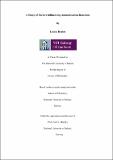A study of factors influencing anomerisation reactions

View/
Date
2016-07-18Author
Kerins, Louise
Metadata
Show full item recordUsage
This item's downloads: 138 (view details)
Abstract
This thesis involves an investigation into the anomerisation reaction and strategies by which the reaction can potentially be improved and provide a greater understanding of factors influencing the reaction. There has been extensive research into the anomerisation reaction in carbohydrate chemistry, including work by Murphy and co-workers. The use of Lewis acids such as TiCl4 and SnCl4 has been adopted by the Murphy group in the anomerisation of a wide variety of glycosides. However, it is considered that a more thorough understanding of the anomerisation reaction could be achieved by studying the effect of protecting groups and modifying the structure of the glycoside.
Chapter 2 involves the study of the anomeric effect of a variety of uronic acid derivatives and the corresponding pyranose sugars. Previous research has involved the synthesis of α-glycosides, particularly galactosides and glucuronides through chelation induced anomerisation. High α-selectivities were achieved with the uronic acids in particular, which was thought could be at least partly due to a higher anomeric effect in such saccharides. A series of hemiacetals of gluco- and galacturonic acid derivatives were synthesized and their anomeric effect was determined. These findings were compared to the anomeric effect of corresponding pyranose hemiacetals. Results from this study were then discussed and attempts were made to correlate data with findings from Lewis acid induced anomerisations.
Chapter 3 deals with the investigation into the use of different uronic acid esters in anomerisation reactions. Research by the Murphy group has found that the use of use of uronic acids or its methyl ester gave high yields of 1,2-cis glycoside and a high rate of reaction. An examination into the use of alternative uronic acid esters was then undertaken to explore if the rate of anomerisation or yield of α anomer could be increased. A series of galacturonic acid derivatives were synthesized, where the nature of the ester was varied throughout. High α-selectivities were obtained and the rates of anomerisation were successfully determined by 1H-NMR in each case and in some cases were faster than for the methyl ester derivatives.
Chapter 4 involved a study of the effect of various acyl protecting groups on the rate of anomerisation. The rate of anomerisation was determined for a number of both glucopyranosides and galacturonic acid derivatives. Efforts to correlate rates of anomerisation reactions with a variety of electronic and steric parameters were carried out. In the galacturonic acid study, multidimensional steric parameters could be directly correlated for various substituents, including Ph, in a linear manner with log k. In general, the study revealed that both steric and electronic factors can influence the kinetics of anomerisation reactions.

